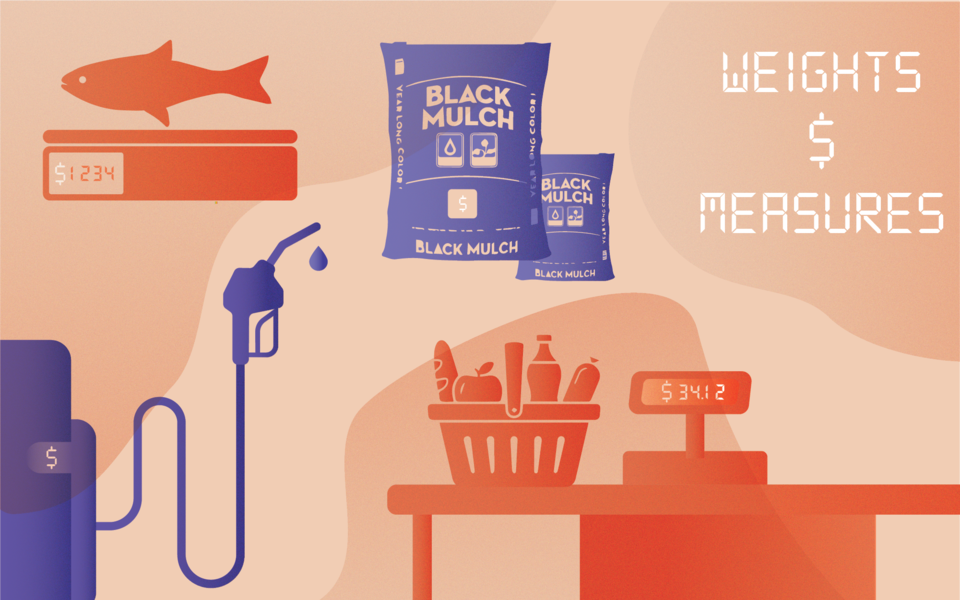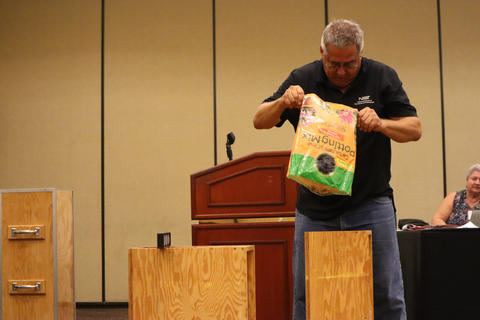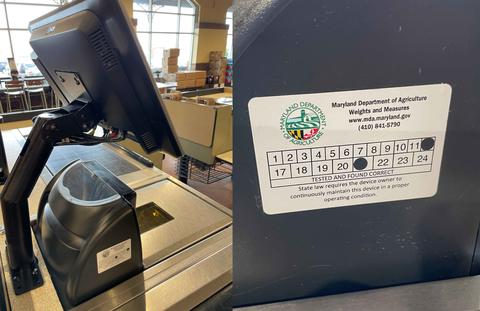Taking Measure
Just a Standard Blog

It seems like many items in our everyday lives have been getting more expensive lately. Here at NIST, we are committed to making sure you get what you pay for when buying something based on weight or measure, such as food or fuel. We also work to make sure sellers get fair payment for the goods and services they provide.
Today marks the first day of Weights and Measures Week, when we celebrate the anniversary of President John Adams signing the first U.S. weights and measures legislation into law.
Many things we buy today — cereal, milk, propane in tanks for your grill, mulch, and the list goes on and on — go through a state weights and measures system you’ve probably never thought about.
The economic impact is significant. Nearly half of the value of all goods and services in the U.S., known as gross domestic product, is impacted by the sales of a product or service related to weights and measures.
NIST works with our partners at the National Conference on Weights and Measures to develop nationwide, uniform standards for these measurements. The states voluntarily adopt these standards. States hire inspectors, and we help train them on how to test and apply our standards in the grocery store, at the gas station, or at other businesses.
We can’t celebrate Weights and Measures Week without throwing a party. So, get in, savvy consumer, we’re going shopping and need to make a few stops. You can see how weights and measures play out in your daily life.
Stop 1: Gas Station or EV Charging Station
Before we go to the store, we need to fill up the tank.
When we get to the gas station, there’s a sticker on the gas pump saying the pump has been inspected by your state or local weights and measures program. The inspector makes sure you’re getting what you pay for when you buy gas. It’s always important, but especially so when prices are high.
At NIST, we publish handbooks with performance standards for evaluating such devices for the inspectors to use in their work.
If you’re driving an electric vehicle (EV) on our shopping spree and want to charge up along the way, that charging infrastructure has not yet been built out in every state. Our NIST team is working with our stakeholders to develop standards for the charging devices at those stations. These standards will become more critical to protect consumers as EVs and the charging station infrastructure become more prevalent on the road.
If you think you’re being shortchanged at a gas or EV charging station, contact the business owner or your state’s weights and measures office to report the concern.
Stop 2: Home Improvement/Garden Store

Next, we’ll stop by the home improvement store and get some mulch to spruce up the yard before guests arrive.
Mulch is sold by volume. When you buy a bag, you want to know you’re getting what you pay for. NIST trains state-employed weights and measures inspectors to make sure you’re getting enough in your mulch bags.
We have a test procedure including test equipment and devices from our handbook for checking the net contents of packaged goods. Most states voluntarily adopt our procedures and enforce these regulations.
For example, we show inspectors how to empty a bag of mulch properly and determine the net contents. Inspectors need to make sure the retailer is selling it appropriately and the consumer is getting what they paid for.
Some manufacturers may learn through this process that they’re overfilling their mulch bags. The inspection process puts all sellers on equal footing. We want to make sure that not only are consumers getting what they pay for, but also that businesses are being paid fairly for their goods and services.
Stop 3: Grocery Store

Next, let’s go to the grocery store to get snacks for our party.
When you buy food by weight, you don’t pay for the package it comes in. When your food items are weighed at checkout, the cashier must deduct the weight of the packaging material of the food item, known as “tare.” Sometimes the scale deducts this automatically.
So, if we’re making salsa for our Weights and Measures Week party, we only pay for the tomatoes, not the bag they came in. Likewise, if you’re buying food from the salad bar, you’re paying for the weight of the salad, not the container.
Just like at the gas station, weights and measures inspectors are checking scales where food is weighed to make sure that they are accurate. NIST makes sure those inspectors are equipped with the right information they need to do their jobs.
Here’s how to know you’re getting what you’re paying for with items directly weighed in your presence at the store:
- The scale should be at zero before weighing.
- The unit price should be accurate for the item you’re buying.
Additionally, many store scales will display the tare value deducted.
If you think that tare weight is not accounted for during the sale, ask the clerk at the service counter or the store manager. If you think your store’s scale may not be accurate or if you think tare is not being deducted, it’s your right to contact your state’s weights and measures program. Report your concern, and they will determine if an inspector needs to do an extra check.
Stop 4: Seafood Market
We want to add some shrimp to this party menu, so let’s head over to the seafood market.
If you’re buying expensive seafood by weight, the last thing you want to pay extra for is ice. And you don’t!
If there’s an ice glaze on frozen seafood you’re buying, especially common with prepackaged shrimp, you cannot be charged for that. Weights and measures inspectors make sure that once the ice glaze is removed, your seafood still weighs what is claimed on the package. So, if your bag of shrimp has a label that says it weighs 908 grams (2 pounds), the shrimp still needs to weigh the same as it’s labeled after the ice glaze has thawed, and the resulting water drains out.
Thank an Inspector
As consumers, it is unlikely that we will test the weight of our prepackaged goods. However, we rely on our state’s weights and measures programs and their inspectors to periodically conduct tests to ensure equity in the marketplace for both shoppers and businesses alike.
Happy Weights and Measures Week! And don’t forget to #ThankanInspector before you enjoy that party food!
About the author
Related Posts
Comments
Great information for the public. Good job.
I live on south Whidbey Island. in Island County in the state of Washington. The gas prises are really high maybe I'm wrong, but I think they are too high. You might want to check it out if you get a chance.
Hi, Gary. Thanks for your comment. You would report this to your state's weights and measures office - https://agr.wa.gov/services/inspections-and-investigations/inspections/….
WE all aprieciatte your efforts providing knowledge to our Market Century and new ERA of Biochemistry Implementation.
sincerely. Kennet Cruz Ochoa. Happy Holliday season.
Saturday, December 7th, 2024.
Are there any controls for weights and measures for amount of water consumed by STATES water districts? I found out the water district in California (CVWD) use a meter reading volume of water used to charge customers based on a battery measuring flow and volume by water passing through a rectangular orifice in meter reading IONS of water passing through it.
Excessive and unbelievable amounts of water being charged to customers with no recourse.
These meters are set-uo to read, display, and send info back to the district by way of WI-FI to charge customers. My issue started with an extremely high bill of $691.00 for I normally only was billed #120. or there abouts.
I see the PROBLEM as these meters use a Lithium battery NOT REPLACEABLE AND NOT RECHARGABLE,
and not warranted unless done by manufacture. They were sold under the pretext The BATTERY had a 20 year life span but findings have found the battery's only have a life span of 10 years. My meter was installed in 2013 and obviously failed since 2021. This problem exists throughout the country as some WATER districts get rid of them or replace them. NOT OUR DISTRICT. so they have to lie to the customer and tell them YOU HAVE THE PROBLEM and their meters are accurate.
My concern is the millions of customers don't know where to turn, so they keep paying for whatever the meter and battery says even when it crashes.
Hi, Spencer. Thanks for your comment. You can find contact information for your state's weights and measures office here: https://www.nist.gov/pml/owm/resources-weights-and-measures/state-weigh….






Useful information